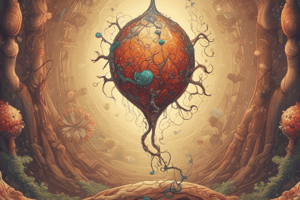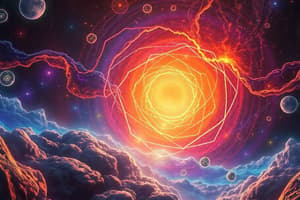Podcast
Questions and Answers
What did the Miller-Urey experiment demonstrate about the origin of life?
What did the Miller-Urey experiment demonstrate about the origin of life?
- Chemical reactions are not necessary for the formation of life.
- Life originated only from extraterrestrial sources.
- Organic molecules can only form from other organic molecules.
- Organic molecules can form from simple inorganic compounds. (correct)
Which of the following is NOT a characteristic of prokaryotes?
Which of the following is NOT a characteristic of prokaryotes?
- They are single-celled organisms.
- They are simpler in structure than eukaryotes.
- They lack a nucleus.
- They have membrane-bound organelles. (correct)
Which class of animals is characterized by the presence of a notochord and dorsal nerve cord?
Which class of animals is characterized by the presence of a notochord and dorsal nerve cord?
- Platyhelminthes
- Arthropoda
- Chordata (correct)
- Cnidaria
What is the main significance of the endosymbiosis theory?
What is the main significance of the endosymbiosis theory?
Which of the following traits is associated with the evolution of mammals?
Which of the following traits is associated with the evolution of mammals?
Which evolutionary trend is characterized by the development of complex body plans and cavities in animals?
Which evolutionary trend is characterized by the development of complex body plans and cavities in animals?
What adaptation does the amniotic egg provide for reproduction?
What adaptation does the amniotic egg provide for reproduction?
Which of the following statements about eukaryotic cells is true?
Which of the following statements about eukaryotic cells is true?
What are protobionts hypothesized to be precursors to in the evolution of life?
What are protobionts hypothesized to be precursors to in the evolution of life?
Which of the following environmental changes contributed to the history of life on Earth?
Which of the following environmental changes contributed to the history of life on Earth?
What is the main distinguishing feature of eukaryotic cells compared to prokaryotic cells?
What is the main distinguishing feature of eukaryotic cells compared to prokaryotic cells?
The endosymbiosis theory explains the origin of which organelles?
The endosymbiosis theory explains the origin of which organelles?
Which group of animals is characterized by having an exoskeleton?
Which group of animals is characterized by having an exoskeleton?
Which trait is a defining characteristic of chordates?
Which trait is a defining characteristic of chordates?
Which of the following represents the correct order of evolutionary transitions in vertebrates?
Which of the following represents the correct order of evolutionary transitions in vertebrates?
Which group of mammals is characterized by precocial young that develop inside a pouch?
Which group of mammals is characterized by precocial young that develop inside a pouch?
Flashcards
Miller-Urey experiment
Miller-Urey experiment
Demonstrated organic molecules can form from inorganic compounds under early Earth conditions.
Protobionts
Protobionts
Simple cell-like structures, precursors to cells, formed from organic molecules.
Oxygenation of atmosphere
Oxygenation of atmosphere
Change in the Earth's atmosphere, primarily the introduction of oxygen.
Multicellularity
Multicellularity
Signup and view all the flashcards
Endosymbiosis Theory
Endosymbiosis Theory
Signup and view all the flashcards
Prokaryotes
Prokaryotes
Signup and view all the flashcards
Eukaryotes
Eukaryotes
Signup and view all the flashcards
Amniotic egg
Amniotic egg
Signup and view all the flashcards
What formed first: DNA or RNA?
What formed first: DNA or RNA?
Signup and view all the flashcards
Cyanobacteria
Cyanobacteria
Signup and view all the flashcards
Cambrian Explosion
Cambrian Explosion
Signup and view all the flashcards
What distinguishes prokaryotes from eukaryotes?
What distinguishes prokaryotes from eukaryotes?
Signup and view all the flashcards
Three Life Domains
Three Life Domains
Signup and view all the flashcards
What does the Endosymbiosis Theory explain?
What does the Endosymbiosis Theory explain?
Signup and view all the flashcards
Chordates
Chordates
Signup and view all the flashcards
How did the Amniotic Egg enable vertebrates to colonize land?
How did the Amniotic Egg enable vertebrates to colonize land?
Signup and view all the flashcards
Study Notes
Origin of Life
- Miller-Urey experiment showed organic molecules can form from inorganic compounds under early Earth conditions.
- Protobionts are simple, cell-like structures, thought to be precursors to cells.
- RNA was likely the first genetic material.
- Early Earth conditions included environmental changes like oxygenation, volcanic activity and glaciation.
- Photosynthetic cyanobacteria introduced oxygen to the atmosphere.
History of Life on Earth
- Multicellularity evolved, followed by major diversification during the Cambrian Explosion.
- Animals emerged 600 million years ago
- Evolution included diverse body plans, digestive systems and nervous systems.
- Cephalization, or development of a head region, occurred in some lineages.
Prokaryotes vs. Eukaryotes
- Prokaryotes are single-celled organisms without a nucleus (e.g., bacteria, archaea).
- Eukaryotes have a nucleus and membrane-bound organelles (e.g., plants, animals).
- Eukaryotes are generally larger and more complex than prokaryotes.
Three Domains of Life
- Bacteria, Archaea, and Eukarya are the three domains based on genetic differences.
- Archaea and Eukarya share a more recent common ancestor than either do with Bacteria.
Origin of Eukaryotic Cells
- Endosymbiosis theory proposes that mitochondria and chloroplasts originated from prokaryotic cells engulfed by a larger cell.
Major Animal Phyla
- Cnidaria (radial symmetry, stinging cells).
- Platyhelminthes (flatworms, no body cavity).
- Annelida (segmented worms).
- Mollusca (shell, diverse body plans).
- Nematoda (roundworms, pseudocoelomate).
- Arthropoda (exoskeleton, segmented bodies).
- Echinodermata (radial symmetry as adults).
- Chordata (notochord, dorsal nerve cord).
Evolutionary Trends in Animals
- Multicellularity arose in various lineages.
- Body plans and cavities become more complex.
- Digestive and nervous systems diversified.
- Cephalization, the development of a head region and concentration of sensory organs, evolved in some lineages.
Vertebrates
- Jawless fish evolved into cartilaginous and bony fish, then amphibians, reptiles, birds, and mammals.
- Key chordate traits include notochord, dorsal nerve cord, pharyngeal slits, and a post-anal tail.
The Amniotic Egg
- The amniotic egg was a major adaptation allowing for terrestrial reproduction, offering protection for the developing embryo.
Evolution of Mammals
- Three main groups are monotremes (lay eggs), marsupials (pouch development), and eutherians (placental mammals).
Evolution of Humans
- Defining traits of humans include bipedalism, large brain size, tool use, and complex social structure.
Studying That Suits You
Use AI to generate personalized quizzes and flashcards to suit your learning preferences.
Description
Explore the fascinating journey from the origin of life on Earth through key events like the Miller-Urey experiment and the evolution of multicellularity. This quiz covers essentials on prokaryotes vs. eukaryotes and major developmental milestones in life's history. Test your knowledge on the building blocks of life and their progression through time.




